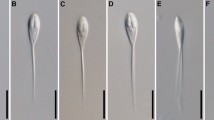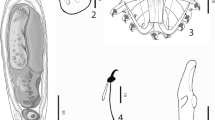Abstract
Gyrodactylus laevisoides n. sp. is described from the gill rakers of red belly dace, Phoxinus eos Cope (Cyprinidae), from Nova Scotia, Canada. Gyrodactylus laevisoides n. sp. is the second species of Gyrodactylus Nordmann, 1832 described from this host and is characterised by weakly curving hamuli, a small ventral bar lacking anterolateral processes, stout dorsal bar, small marginal hooks with sickles larger proximally than distally and having a small circular process on the heel, a MCO with spines arranged in two arched rows, and lack of obvious excretory bladders. The new species most closely resembles Gyrodactylus laevis Malmberg, 1957, a Eurasian species whose principle host is Phoxinus phoxinus (L.). The two species are separated by Gyrodactylus laevisoides n. sp. having less divergent and longer hamulus root and marginal hook sickle toe with a steeper continuous angle and heel that is less prominent. The morphological description is supplemented with sequences of the 18S gene (449 bp, including the V4 region) and of the ITS region (821 bp). Gyrodactylus sedelnikowi Gvosdev, 1950 infecting Barbatula barbatula (L.) and Gyrodactylus neili Leblanc, Hansen, Burt & Cone, 2006 infecting Esox niger Lesueur are the most genetically similar species on GenBank for the 18S rRNA gene and ITS regions respectively (c.96% and c.92%). Gyrodactylus laevisoides n. sp. belongs to Malmberg’s subgenus Gyrodactylus (Gyrodactylus) and phylogenetic analysis of the ITS region groups this species with other members of the subgenus. The phylogeny has two main clades, one comprised of Eurasian species and the other of North American species, specifically Gyrodactylus laevisoides n. sp. and Gyrodactylus neili. It is suspected that this lineage, which is seemingly underrepresented in North America, likely colonised the new world with an ancestral species of Phoxinus via the Bering land connection around the time of the Pliocene.



Similar content being viewed by others
References
Cable, J., Harris, P. D., Tinsley, R. C., & Lazarus, C. M. (1999). Phylogenetic analysis of Gyrodactylus spp. (Platyhelminthes: Monogenea) using ribosomal DNA sequences. Canadian Journal of Zoology, 77, 1439–1449.
Chen, X. Y. (1994). Morphology, phylogeny, biogeography and systematics of Phoxinus (Pisces: Cyprinidae). Ph.D. dissertation, University of Kansas, Lawrence, Kansas.
Cone, D. K., Abbott, C., Gilmore, S., & Burt, M. D. (2010). A new genus and species of gyrodactylid (Monogenea) from silver hake, Merluccius bilinearis, in the Bay of Fundy, New Brunswick, Canada. Journal of Parasitology, 96, 681–684.
Cone, D. K., & Dechtiar, A. O. (1984). Gyrodactylus fryi n. sp. (monogenea) from Esox masquinongy Mitchill in Ontario. Canadian Journal of Zoology, 62, 1089–1090.
Harris, P. D., Cable, J., Tinsley, R. C., & Lazarus, C. M. (1999). Combined ribosomal DNA and morphological analysis of individual gyrodactylid monogeneans. Journal of Parasitology, 85, 188–191.
Harris, P. D., Shinn, A. P., Cable, J., Bakke, T. A., & Bron, J. E. (2008). GyroDb: Gyordactylid monogeneans on the web. Trends in Parasitology, 24, 109–111.
Kimura, M. (1980). A simple method for estimating evolutionary rates base substitutions through comparative studies of nucleotide sequences. Journal of Molecular Evolution, 16, 111–120.
Kritsky, D. C., Leiby, P. D., & Kayton, R. J. (1978). A rapid stain technique for the haptoral bars of Gyrodactylus species (monogenea). Journal of Parasitology, 64, 172–174.
Leblanc, J., Hansen, H., Burt, M., & Cone, D. (2006). Gyrodactylus neili n. sp. (Monogenea: Gyrodactylidae), a parasite of chain pickerel Esox niger Lesueur (Esocidae) from freshwaters of New Brunswick, Canada. Systematic Parasitology, 65, 43–48.
Lindsay, C. C., & McPhail, J. D. (1986). Zoogeography of fishes of the Yukon and Mackenzie Basins. In: Hocutt, C. H. & Wiley E. O. (Eds.), The Zoogeography of North American Freshwater fishes. New York: John Wiley and Sons, pp. 639−674.
Malmberg, G. (1970). The excretory systems and the marginal hooks as a basis for the systematics of Gyrodactylus (Trematoda, Monogenea). Arkiv för Zoologi, 2, 1–235.
Paladini, G., Huyse, T., & Shinn, A. P. (2011). Gyrodactylus salinae n. sp. (Platyhelminthes: Monogenea) infecting the south European toothcarp Aphanius fasciatus (Valenciennes) (Teleostei, Cyprinodontidae) from a hypersaline environment in Italy. Parasites & Vectors, 4, 1–12.
Schelkle, B., Paladini, G., Shinn, A. P., King, S., Johnson, M., van Oosterhout, C., Mohammed, R. S., & Cable, J. (2011). Ieredactylus rivuli gen. et sp. nov. (Monogenea, Gyrodactlyidae) from Rivulus hartii (Cyprinidontiformes, Rivulidae) in Trinidad. Acta Parasitologica, 56, 360–370.
Shinn, A. P., Hansen, H., Olstad, K., Bachmann, L., & Bakke, T. A. (2004). The use of morphometric characters to discriminate specimens of laboratory-reared and wild populations of Gyrodactylus salaris and G. thymalli (Monogenea). Folia Parasitologica, 41, 239–252.
Shinn, A. P., Harris, P. D., Cable, J., Bakke, T. A., Paladini, G., & Bron, J. E. (2010). GyrodDb. World Wide Web electronic publication. www.gyrodb.net, version (06/2010). Accessed 20 July 2013.
Stasiak, R. (2006). Northern red belly dace (Phoxinus eos): a technical conservation assessment. Resource document. USDA Forest Service, Rocky Mountain Region. http://www.fs.fed.us/r2/projects/scp/ assessments/northernredbellydace.pdf. Accessed 20 July 2013.
Tamura, K., Peterson, D., Peterson, N., Stecher, G., Nei, M., & Kumar, S. (2011). MEGA5: Molecular evolutionary genetics analysis using maximum likelihood, evolutionary distance, and maximum parsimony methods. Molecular Biology and Evolution, 28, 2731–2739.
Acknowledgements
The authors thank Xiang Zhang for technical assistance as well as the New Brunswick Museum (Canada) and the Royal BC Museum (Canada) for funding taxonomic work. We acknowledge the support of the Canadian Healthy Oceans Network. This work was funded in part by a Natural Sciences and Engineering Research Council (NSERC) CGS-D grant awarded to SDK and a NSERC Discovery grant awarded to PB.
Author information
Authors and Affiliations
Corresponding author
Rights and permissions
About this article
Cite this article
King, S.D., Cone, D.K., Mackley, M.P. et al. Gyrodactylus laevisoides n. sp. (Monogenea: Gyrodactylidae) infecting northern redbelly dace Phoxinus eos Cope (Cyprinidae) from Nova Scotia, Canada. Syst Parasitol 86, 285–291 (2013). https://doi.org/10.1007/s11230-013-9450-7
Received:
Accepted:
Published:
Issue Date:
DOI: https://doi.org/10.1007/s11230-013-9450-7




